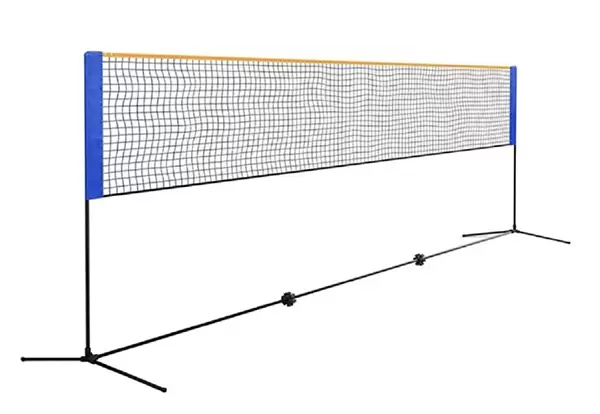Rugby is a sport defined by strength, speed, and precision. But behind every successful training session lies one often-overlooked piece of equipment: the rugby net.
Learn More
Selecting the right children’s badminton practice net is crucial for schools, training centers, and sports academies. A well-designed net ensures safety, effective training, durability, and cost-efficiency, while an unsuitable net can lead to frequent replacements, safety hazards, or suboptimal practice results.
Riches Net, with over 23 years of experience, produces high-quality sports nets with tight knots, accurate dimensions, vibrant colors, and long service life, making them an ideal choice for institutional setups.
This guide dives directly into what schools and training centers should consider when choosing a badminton practice net for children, focusing on net type, material quality, size, safety, maintenance, and cost-benefit analysis.
When selecting a badminton net for children, one of the first considerations is the net structure:
Single-Layer Nets: Lightweight and cost-effective, suitable for beginner players. They provide adequate ball containment but may wear faster in high-frequency use.
Multi-Layer or Reinforced Nets: Feature additional layers or thicker mesh to resist wear and tear. Suitable for schools with multiple classes or training centers with high traffic, ensuring long-term durability.
Practical Recommendation: For daily school practice or short sessions, single-layer nets may suffice. For intensive training programs or commercial centers, multi-layer protection ensures reliability and longer service life.
The material determines how the net performs under repeated impacts, environmental conditions, and handling by children:
PE or Nylon Yarn: High-strength polyethylene (PE) or nylon yarn ensures resistance to tearing and stretching, even under aggressive play.
UV and Moisture Resistance: For outdoor courts, the net must withstand sunlight, humidity, and occasional rain without degradation.
Knot Integrity: Tight, consistent knots maintain mesh stability, preventing holes from forming and reducing maintenance needs.
Color Retention: Vibrant net colors not only enhance visual appeal but also indicate net quality and durability.
Riches Net ensures that all nets meet high tensile strength and abrasion resistance standards, making them suitable for both indoor and outdoor institutional use.
Net dimensions must match court size, player age, and training goals:
Height: For children, a standard practice height of 1.55–1.60 meters ensures safe shuttle trajectories and realistic practice conditions.
Width: Net width should cover the court fully, typically 6–10 meters, depending on indoor or outdoor space.
Adjustability: Some nets offer telescopic poles or adjustable frames, allowing height modifications as children grow or for different skill levels.
Proper sizing ensures consistent shuttle trajectories, reduces frustration, and enhances skill development.

Children’s practice nets must prioritize safety:
Soft Edge Cables or Rope: Avoids injury if children accidentally hit or pull on the net.
Stable Frame Systems: Lightweight nets must still be anchored to prevent tipping during active play.
Smooth Surface Mesh: Prevents finger or hand entanglement.
Impact Resistance: Reinforced or multi-layer nets absorb shuttle impact, reducing rebound force that could strike players.
Safety-focused design ensures that schools and training centers meet liability and regulatory standards while promoting safe learning.
Schools and training centers often need nets that are easy to set up, remove, and store:
Freestanding Frames: Allow movement between classrooms or gyms.
Wall-Mounted or Ceiling-Hung Options: Ideal for permanent courts with minimal storage requirements.
Lightweight Construction: Facilitates quick setup by staff without compromising stability.
Foldable or Telescopic Poles: Enable compact storage during non-practice hours.
Riches Net provides both fixed and portable options suitable for multi-use school gyms.
Minimizing maintenance effort is key for institutional buyers:
Weather-Resistant Materials: Reduce the need for frequent replacement or protective covering.
Easy Cleaning: Smooth net surfaces and synthetic fibers allow wipe-down or gentle wash.
Damage Tolerance: Reinforced knots and multi-layer construction reduce tearing from shuttle impact or accidental mishandling.
Proper maintenance practices can extend net life up to 8–10 years, even in high-traffic environments.
Budget considerations are always important for schools:
Single-Layer Nets: Lower upfront costs but may require more frequent replacement in high-use environments.
Reinforced or Multi-Layer Nets: Higher initial cost, but longer lifespan and reduced maintenance costs make them more cost-effective over time.
ROI Analysis: For schools with multiple daily classes, investing in durable nets reduces downtime, replacement costs, and disruption to training schedules.
Indoor vs Outdoor: Outdoor nets must resist UV, moisture, and occasional wind. Indoor nets may focus on impact absorption and lightweight portability.
Frequency of Use: Daily, intensive practice warrants stronger, multi-layer nets. Occasional sessions allow for simpler nets.
Shuttle Speed: Higher-speed training may require reinforced mesh to prevent wear.
These considerations ensure the net matches real-world operational requirements.
Q1: Can a single-layer net be upgraded to a reinforced net?
A1: Yes, modular frames allow the addition of extra layers or stronger nets without replacing the entire setup.
Q2: How do I ensure the net height is appropriate for different age groups?
A2: Adjustable poles or telescopic frames allow easy height modifications as children grow.
Q3: Are outdoor nets more expensive than indoor nets?
A3: Slightly, due to UV-resistant and weatherproof materials, but the longevity justifies the cost.
Q4: How often should school nets be inspected?
A4: Monthly inspection of knots, mesh integrity, and frame stability is recommended to prevent accidents.
Q5: Can nets be customized with school logos or colors?
A5: Yes, Riches Net offers custom colors and branding options for institutional buyers.
Choosing the right children’s badminton practice net for schools and training centers requires careful consideration of net type, material quality, size, safety, durability, and cost efficiency. Single-layer nets may suffice for light recreational use, but reinforced or multi-layer nets provide superior durability, safety, and long-term value for high-traffic or professional training environments.
With more than 23 years of expertise, Riches Net ensures that all children’s badminton practice nets meet strict quality standards, precise dimensions, and long-lasting durability, making them a reliable choice for educational institutions and training centers worldwide.